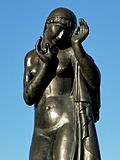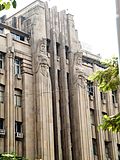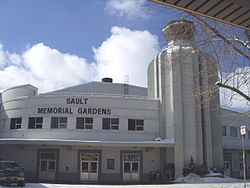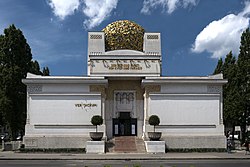Art Deco

Art Deco is a style of decorative art, design and architecture of the 1920s and 1930s in Europe,[1] the United States and other countries. It was named after an international exhibition held in Paris in 1925,[1] but there are some examples dating back to before the First World War.[2] Art Deco followed another design style, Art Nouveau, which was influenced by organic plant-like forms.
Art Deco was one of the first styles of modern architecture. It was influenced by different styles and movements of the early 20th century, Neoclassical, Constructivism, Cubism, Modernism, and Futurism.[3] Later Art Deco of the mid to late 1930s is also sometimes called Streamline Moderne.
One idea behind art deco architecture was to apparently streamline buildings the same way you would streamline a car for aerodynamics. The style was much more common in commercial buildings than in houses; many banks, schools, and libraries were built in this style. Most of the public buildings built by the Works Progress Administration during the Great Depression are in the Art Deco style.
Examples
Famous Art Deco buildings include the Chrysler Building in New York City and the Chicago Board of Trade Building in Chicago. Another is Bullock's Wilshire in Los Angeles. Many art deco buildings have elaborate terra cotta or murals inside them. The towers of the Golden Gate Bridge have an art deco design.
Gallery
Packard sedan, 1941
U.S. postage stamp commemorating the 1939 New York World's Fair
Henryk Kuna, "Rytm" (Rhythm), Warsaw, Poland, 1925
Disused Snowdon Theatre, Montreal
Union Terminal in Cincinnati, Ohio, 1933
Niagara Mohawk Building, Syracuse, New York
Art Deco Media
Grand dining room of the ocean liner SS Normandie by Pierre Patout (1935); bas-reliefs by Raymond Delamarre
Art Deco skyscrapers in Falling Hare (1943).
Secession Building in Vienna by Joseph Maria Olbrich (1897–98)
Austrian Postal Savings Bank in Vienna by Wagner (1904–1912)
Stoclet Palace in Brussels by Josef Hoffmann (1905–1911)
Table and chairs by Maurice Dufrêne and carpet by Paul Follot at the 1912 Salon des artistes décorateurs
Lady with Panther by George Barbier for Louis Cartier (1914). Display card commissioned by Cartier shows a woman in a Paul Poiret gown.
Armchair by Émile-Jacques Ruhlmann (1914), now in the Musée d'Orsay, Paris
References
| Wikimedia Commons has media related to Lua error in Module:Commons_link at line 62: attempt to index field 'wikibase' (a nil value).. |
- ↑ 1.0 1.1 Wilson, Simon; Lack, Jessica (2008). The Tate Guide to Modern Art Terms. Tate. p. 24. ISBN 978-1-85437-750-0.
- ↑ Texier, Simon (2012). Paris, panorama de l'architecture de l'antiquite a nos jours. p. 128. ISBN 978-2-84096-667-8.
- ↑ Hillier, Bevis (1968). Art Deco: of the 20s and 30s. Studio Vista. p. 12. ISBN 978-0-289-27788-1.
- ↑ "Mumbai's latest endangered species: its art deco heritage". Urban architecture.in. January 4, 2009. Archived from the original on June 29, 2012. Retrieved August 15, 2009.





















